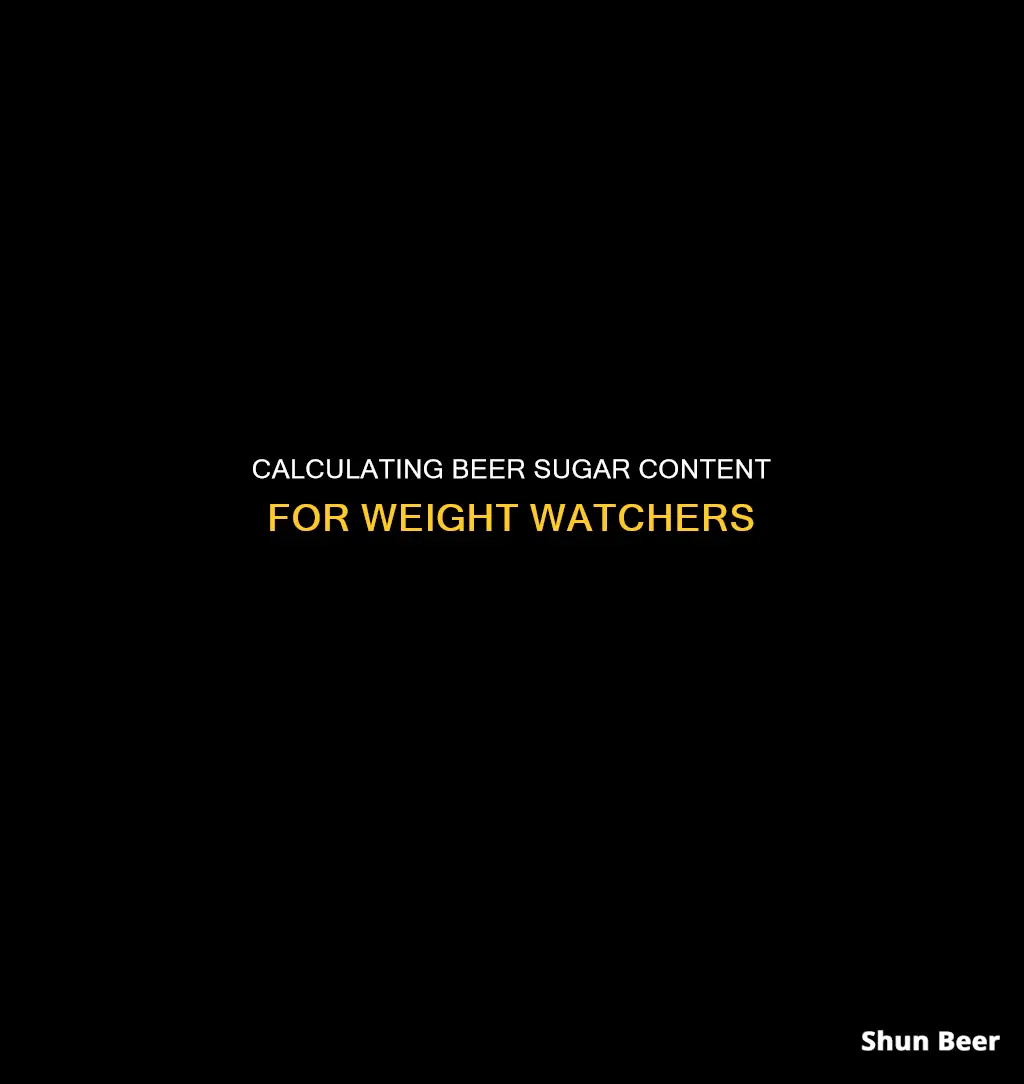
Beer is a popular alcoholic beverage, but its sugar content can be a concern for those watching their weight. While beer has relatively low sugar content, with most beers containing around 2-6 grams of sugar per serving, it is important to consider the other nutritional aspects of beer when trying to maintain a healthy weight. Beer is calorie-dense, with alcohol providing seven calories per gram, almost as much as fat, which has nine calories per gram. Therefore, when trying to figure out the sugar content of beer for weight watchers, it is essential to consider the overall calorie intake and the impact of alcohol on weight management. Additionally, the serving size and the specific type of beer can also affect the sugar content, with some beers having up to 8 grams of sugar per serving.
| Characteristics | Values |
|---|---|
| Beer belly | Myth |
| Calories in beer | Alcohol is the most significant source of calories in beer |
| Beer with the least calories | Non-alcoholic beer |
| Beer with the most calories | The stronger the beer, the more calories |
| Average 12-ounce beer with 5% alcohol by volume | 5 Points |
| Typical 16-ounce draft pint | 6 Points |
| Most 12-ounce "light" beers | 3 Points |
| 16-ounce pint of light beer | 4 Points |
| 12-ounce non-alcoholic beer | 2 Points |
| Sugar in beer | Beer has very little sugar |
| Calories in sugar | 4 calories per gram |
| Calories in alcohol | 7 calories per gram |
What You'll Learn

Calculating sugar in beer for Weight Watchers
While beer is often associated with the idea of a "beer belly", this is actually a myth, according to Charlie Bamforth, PhD, a professor at the University of California, Davis. He states that any weight gain from drinking beer is due to a high total calorie intake and a lack of exercise, rather than the beer itself.
That being said, beer is still a calorie-dense beverage, with alcohol providing seven calories per gram, almost as much as fat, which has nine calories per gram. Therefore, it is important for Weight Watchers participants to be mindful of their beer consumption and choose their brews carefully.
The Weight Watchers program assigns Points values to different foods and beverages, including beer, to help guide participants in making healthier choices. The Points values for beer are generally based on the serving size and the alcohol content, with higher alcohol content leading to more Points.
For example, a 12-ounce beer with 5% alcohol by volume typically has a Points value of 5, while a 16-ounce draft pint with the same alcohol content has a Points value of 6. Non-alcoholic and light beers have lower Points values, with a 12-ounce non-alcoholic beer having 2 Points and most 12-ounce light beers having 3 Points.
When it comes to calculating the sugar content in beer for Weight Watchers, it is important to note that beer generally has very little sugar. However, certain types of beer, such as smoothie beers, may contain higher amounts of residual sugar due to the addition of fruit puree and lactose.
To calculate the exact sugar content in a specific type of beer, you would need to refer to the nutritional label, if available. You can then use the Weight Watchers PointsPlus calculator, taking into account the alcohol content and sugar content, to determine the Points value.
Additionally, there are general rules of thumb provided by Weight Watchers participants that can be helpful in estimating the Points values for beer. For example, one regular beer is typically equivalent to 5 PointsPlus, while one light beer is equivalent to 3 PointsPlus.
By understanding the Points values of different beers and considering their sugar and alcohol content, Weight Watchers participants can make informed choices about their beer consumption while still enjoying the occasional cold one.
Beer and Blood Sugar: What's the Connection?
You may want to see also

Sugar content in different beers
Beer is a popular alcoholic beverage, and its sugar content is a common concern for health-conscious drinkers. The sugar content in beer varies depending on the type, brand, and brewing method. Here is a detailed overview of the sugar content in different beers:
Regular Beer vs. Light Beer
Regular beers tend to have slightly higher sugar content than light beers due to their reduced carbohydrate content. Light beers generally have less sugar and fewer calories. However, they may also lack the flavour and richness of regular beers. Examples of light beers include Guinness Draught Light and Pabst Blue Ribbon Light.
Beer Gravity
Beer gravity is a measure of the concentration of sugars in the wort, which is the liquid extracted from malted barley during brewing. High-gravity beers contain more sugar, resulting in higher sugar levels post-fermentation. On the other hand, low-gravity beers typically have less sugar and a lower alcohol content.
Beer Styles
Different styles of beer have varying sugar levels. Lagers and pilsners tend to contain less sugar, while heavier, malty beers like stouts and India Pale Ales (IPAs) might have higher sugar levels. Certain real ales may also have additional flavouring with extra sugar or honey, so their sugar content can vary.
Non-Alcoholic Beer
Non-alcoholic beers tend to have slightly higher sugar levels than their alcoholic counterparts because the sugar is not converted into alcohol during fermentation. However, these sugar amounts are still relatively low.
Specific Beer Brands
The sugar content can vary even among popular beer brands. Here are the sugar contents of some well-known beers:
- Heineken: 0 grams of sugar per 12 ounces
- Miller High Life: 0 grams of sugar per 12 ounces
- Miller Lite: 0 grams of sugar per 12 ounces
- Coors Banquet: 0 grams of sugar per 12 ounces
- Coors Light: 1 gram of sugar per 12 ounces
- Budweiser: 0 grams of sugar per 12 ounces
- Bud Light: 0 grams of sugar per 12 ounces
- Busch: No sugar reported per 12 ounces
- Busch Light: No sugar reported per 12 ounces
Weight Watchers Points
For those following the Weight Watchers program, beer consumption can impact their points. According to the program, one regular beer (12 ounces with 5% alcohol by volume) is equivalent to 5 Points, while a light beer is typically 3 Points. A 16-ounce draft pint is considered 6 Points. Additionally, a non-alcoholic beer (12 ounces) is 2 Points.
In conclusion, the sugar content in beer varies depending on the specific type and brand. Beer gravity, brewing methods, and added ingredients all play a role in the final sugar content. When consumed in moderation, beer can be a part of a well-balanced and enjoyable lifestyle.
Beer and Blood Sugar: What's the Connection?
You may want to see also

Calories in beer
Beer is a popular alcoholic drink, but it's important to be aware of its calorie content, especially if you're watching your weight. The number of calories in beer can vary depending on the type, brand, and serving size. Here's a detailed guide to help you understand the calories in beer and make informed choices.
Factors Affecting Calorie Content
The calorie content of beer depends on several factors, primarily the alcohol content and the serving size. In general, the higher the alcohol percentage, the more calories the beer will contain. This is because alcohol is calorie-dense, with seven calories per gram, which is close to the calorie content of fat, which has nine calories per gram. Therefore, stronger beers tend to have more calories.
Additionally, the serving size also plays a crucial role. A typical serving size for beer is 12 ounces, but it's not uncommon to find larger servings, such as 16-ounce pints. Naturally, a larger serving will contribute more calories.
Calorie Content of Different Beers
To give you an idea of the calorie content of different beers, here are some examples:
- A 12-ounce beer with 5% alcohol by volume typically has around 150 calories.
- A 16-ounce draft pint (typically containing 5% alcohol) has around 180 calories.
- A 12-ounce "light" beer usually has fewer calories, often around 95-100 calories.
- Non-alcoholic beers have significantly fewer calories, with a 12-ounce bottle of Beck's NA (0.05% ABV) containing only 57 calories.
- Darker beers, such as stouts and brown ales, tend to have more calories, with some stouts containing up to 210 calories per serving.
- Premium or stronger beers can have even higher calorie counts, with some premium lagers containing 338 calories per serving.
Calculating Calories
If you want to calculate the calories in a specific beer, you can use the following simple formula:
Calories = ABV% x 2.5 x Ounces of Beer
For example, a 16-ounce beer with 6% ABV would have approximately 240 calories.
Weight Watchers Points
If you're following the Weight Watchers program, it's important to note that they use a points system to help guide your food and drink choices. According to their system:
- The average 12-ounce beer with 5% alcohol is equivalent to 5 points.
- A 16-ounce draft pint is worth 6 points.
- Most 12-ounce "light" beers are 3 points.
- A 16-ounce pint of light beer is 4 points.
- Non-alcoholic beers are typically 2 points.
It's worth noting that the points system takes into account various factors beyond just calories, so it's always best to refer to official Weight Watchers resources for the most accurate information.
Tips for Mindful Drinking
If you're conscious about your calorie intake, there are some strategies you can employ to enjoy beer while being mindful of your overall calorie consumption:
- Opt for lower-calorie beers, such as light beers or non-alcoholic options.
- Be mindful of serving sizes and remember that larger containers may contain two standard servings.
- Alternate alcoholic drinks with non-alcoholic ones to reduce your overall calorie intake.
- Avoid 'premium' or stronger beers, as they tend to have a higher calorie content.
- Be aware that sweetness in drinks can indicate added sugar, which increases the calorie count.
- Eat a healthy snack or meal before drinking to slow the absorption of alcohol and maintain your resolve to make healthier choices.
Beer's Sugar Impact: What Happens in the Body?
You may want to see also

Weight Watchers points for beer
It's important to note that the Weight Watchers points system has evolved over time, and the points for beer may vary depending on the specific plan you are following. The information provided here is based on the sources available and may not reflect the most recent updates to the Weight Watchers program. With that said, let's delve into the topic of Weight Watchers points for beer.
The traditional Weight Watchers plan assigns points to beer based on its calorie content. The average 12-ounce beer with 5% alcohol by volume is typically worth 5 points. The points increase with the size and alcohol content of the beer; a 16-ounce draft pint with the same alcohol percentage is usually 6 points. Non-alcoholic and light beers generally have fewer points. A 12-ounce non-alcoholic beer is often worth 2 points, while most 12-ounce light beers are worth 3 points. A 16-ounce pint of light beer typically has 4 points.
It's worth noting that the points values can vary slightly depending on the specific brand and type of beer. For example, some popular beer brands with 5 or more points include Peroni Nastro Azzurro, Pabst Blue Ribbon (PBR), and Blue Moon Belgian White. On the other hand, beers with 3 or fewer points include Heineken Premium Light, Milwaukee's Best Light, and Yuengling Light Lager.
To make things a bit more complex, the Weight Watchers PointsPlus plan takes into account not just calories but also the protein, fiber, fat, and carbohydrate content of the beverage. This can be challenging with alcoholic drinks, as their nutritional information is often limited. In general, for a 12-ounce bottle of beer, you can round up the percentage of alcohol to get the PointsPlus value. So, for instance, a beer with 4.8% alcohol content would be worth 5 PointsPlus.
Additionally, it's important to be mindful of the sugar content in beer, especially in certain varieties. "Smoothie beers," for instance, are known to contain significant amounts of residual sugar from added fruit puree and lactose, making them calorie-dense. While beer generally has very little sugar, these specialty beers can skew the numbers.
In conclusion, while it's possible to enjoy a beer while following the Weight Watchers program, it's crucial to be mindful of the points values and choose your brew wisely. The points can add up quickly, especially with higher-alcohol and specialty beers. Remember to always refer to the most up-to-date Weight Watchers resources and guidelines to ensure accurate tracking of your points.
Sugar in Beer: How Many Grams?
You may want to see also

Weight Watchers points for other alcoholic drinks
Beer is just about as caloric as any other alcoholic drink. The stronger the beer, the more calories it contains. Alcohol is calorie-dense, packing seven calories per gram. That's almost as much as fat, which has nine calories per gram.
The average 12-ounce beer with 5% alcohol by volume is 5 points. The typical 16-ounce draft pint is 6 points. Most 12-ounce "light" beers are 3 points. A 16-ounce pint of light beer has 4 points. A 12-ounce non-alcoholic beer has 2 points.
- Light beer: Corona Light, Miller Light, Michelob Ultra, Coors Light, and Sam Adams Light are all three SmartPoints.
- Red or white wine: 4 SmartPoints per serving.
- Liquor: Nearly all liquors (rum, vodka, gin, tequila, whiskey, etc.) are 3 SmartPoints for a 1.5-ounce serving.
- Mixed drinks: A traditional 6-ounce margarita will cost you 17 SmartPoints, but you can make a 3-point "margarita" by pouring 1.5 ounces of tequila over ice, adding fresh lime juice, and topping it with Sprite Zero.
- Skinny Margarita: 3 points.
- Vodka: Most vodka is 3 points for 1.5 fluid ounces, but SkinnyGirl Vodka is 1 point, and Deep Eddy's vodka is 2 points for 1 ounce.
- Low-calorie mixers: Use diet soda, club soda, sparkling water, or sugar-free drink mixes to mix your drinks without adding extra points.
If you're trying to lose weight, it's best to avoid alcohol altogether. Alcoholic drinks are typically high in calories and sugar and can hinder your weight loss efforts. However, if you're on Weight Watchers, everything is allowed in moderation, even cocktails. Choose drinks that are low in SmartPoints and be mindful of your portions to stay on track with your weight loss goals.
Budweiser Beer: Sugar Content and Nutritional Facts
You may want to see also
Frequently asked questions
5 points.
6 points.
3 points.







